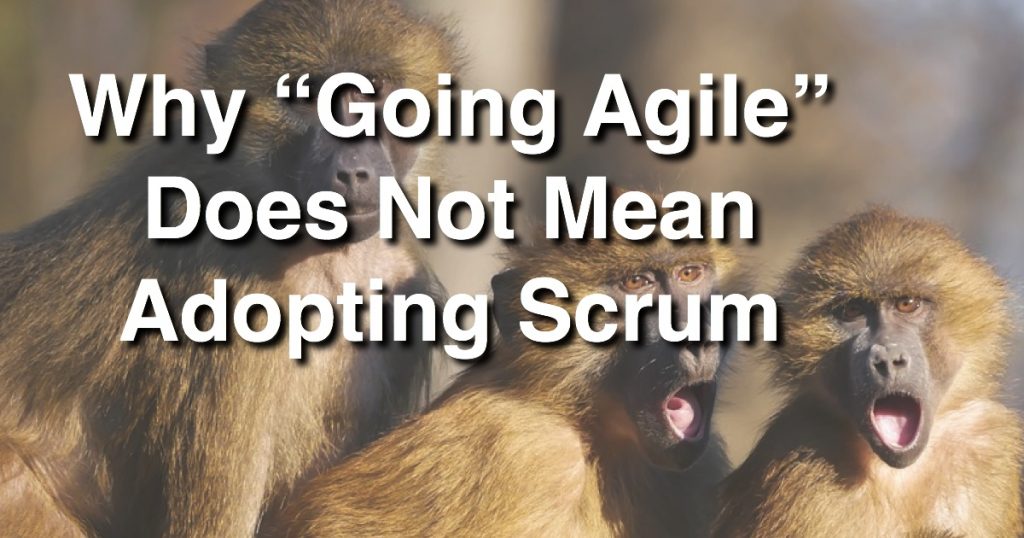The process is common everywhere, “we are going Agile so we’re gonna to do Scrum.” And, thus, teams go off and take some classes, get someone certified as a Scrum Master, and begin to change how work is done by trying to follow the methods prescribed in the Scrum Guide. Sound familiar? As this wholesale change is being pushed, folks are confused, some [many] resist, and chaos ensues. Rumbling and complaining echo throughout the office. Results suck. The ones pushing this overarching change make themselves feel better by saying this is part of the normal forming, storming, norming process. After all, they reason, people just need to get used to the new practices and all will be well.
You can be Agile without ever doing a single practice of Scrum, and you can do Scrum without ever being Agile. Share on XWhen the DIY approach lacks progress, the organization breaks down and hires outside coaches (a.k.a people with Certified Scrum Master certifications) to come in and make it all better. Perhaps the team eventually settles into the processes and practices, but are they “Agile”? Maybe not, but everyone believes they are now Agile because they are “doing Agile” and leadership looks to how they can standardize this “success” across other teams.
What’s the Problem?
What I just described is a very common occurrence in organizations, perhaps even in yours. I have obviously positioned this progression as problematic, so what’s the problem?
”Going Agile” usually does not include sufficient focus on developing the mindset and the why behind what teams do.

The problem is that Scrum, or any framework or methodology for that matter, is not Agile. It’s merely a framework and a set of practices aimed to help teams change how they work with an eye on living out the values and principles that define Agile. The hope is that by “doing” Scrum, teams will eventually learn and understand why they are doing what they are doing and internalize those values and principles (a.k.a the mindset). A team following Scrum can be Agile, however, when the focus is purely on the tactics, that often times doesn’t materialize. That’s the problem – “going Agile” usually does not include sufficient focus on developing the mindset and the why behind what teams do.
“Going” Agile
If implementing Scrum is not the way to “go Agile”, then what is? Before I get into some ideas there, please understand that Scrum can definitely be a valid part of your agile experience. In fact, Scrum absolutely touts Agile values and principles. The key, however, is that Scrum should be used to support that journey, not be the focal point. First and foremost, you must break away from the common practice of making “Agile” synonymous with Scrum or any other framework. Understand that Agile is a mindset, a way of thinking about work that informs how you should go about doing that work. Understand that you can be Agile without ever doing a single practice of Scrum.
I find it’s often better to take on transformation in bite sizes.
I believe the bottom layer of our Agile foundation starts with the Agile Manifesto – its four value statements and corresponding 12 principles. Know them, understand them, and internalize them. Measure everything you “do” against them for alignment. To more fully understand how these values and principles support all things agile, check out Why the Agile Manifesto is the Foundation for Timeless Agility.
Bite Size Transformation
Agile transformations tend to be culture shock – working with an Agile mindset is often very different from how the organization is accustomed to working. As such, I find it’s often better to take on transformation in bite sizes.
Bite by bite, the team will change, for the right reasons, on their terms – for reasons they fully understand and buy into.
If you have struggled with broader transformational challenges, I recommend you start with an Agile value the team can get behind, review the principles that support it, and find one thing the team agrees to change or make better about how they work. Then, and only then, should you be concerned about how you will achieve that – which practices or methods you’ll employ. Maybe it’s a Scrum practice, maybe not. It really does not matter so long as what you’re doing aligns with the values and principles and addresses the problem you are trying to solve. This is an area where a solid Agile coach can help. Armed with that one bite, chew on it for a time. Make changes and keep adjusting what you’re doing until it feels right. Prove it out, get comfortable with it, and use that small success to build trust and confidence for tackling the next change. Bite by bite, the team will change, for the right reasons, on their terms – for reasons they fully understand and buy into.
Summary
Keep in mind, Mindset Transcends Methodology™, which means if you do not build a strong Agile mindset, separate from methodology, you’ll end up lost when the framework trends change. Focus instead on building a Timeless Agility, one that starts with the values, principles, and concepts that define the Agile mindset and determine what you do from there. Many times the best approach to change is in small bites. Better yet, increments that build upon another.
